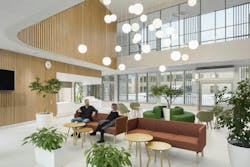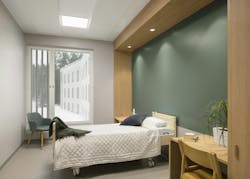A psychiatric clinic in Finland showcases a patient-focused design by C.F. Møller Architects
In Tampere, Finland, a psychiatric clinic at Tampere University Hospital showcases a patient-focused design by C.F. Møller Architects in collaboration with Finnish studio ARCO Architecture Company.
The 30,000-sm (roughly 322,910-sf) Tampere Psychiatric Clinic is a self-contained extension of Tampere University Hospital, located at the hospital’s outer edge and adjacent to a surrounding nature area. The clinic connects with the hospital’s infrastructure while keeping its own identity and privacy.
The project’s design focuses on both patients’ healing process and the staff’s work environment. Private, public, and social spaces—both indoor and outdoor—serve the psychiatric patients’ desire and ability to adapt to everyday life in the outside world.
The clinic’s three U-shaped care buildings face the surrounding natural environment. Together with an administration and activities building, the care buildings form a ring enclosing a shared courtyard, which serves as a communal hub. Activities, visits, and socializing center on the safe and secluded inner courtyard. The layout promotes a sense of community while also respecting each patient’s need for solitude and personal space.
With an understanding of nature as integral to the healing process, the landscaping design by Rambøll aims to create a calming, therapeutic atmosphere. Each building has direct access to outdoor spaces, such as balconies and secluded courtyards. In addition, the buildings’ height maintains a human scale, encouraging connections with the environment.
With 180 beds, the clinic has been organized to maximize daylight and nature views in each patient room, which also reduces the need for artificial lighting. The clinic’s nature focus takes inspiration from a garden at an existing clinic in Pitkäniemi, Finland, while the use of brick and wood draws on Tampere’s industrial heritage.
The care buildings’ paired departments have a shared core for staff and functional purposes, which supports both resourcing efficiency and security. The buildings’ circular structure also ensures short travel distances and enhances communication.
The clinic’s psychiatric units include the emergency, psychosis, crisis, outpatient, somato-psychiatric, neuropsychiatry, mood, neuromodulation, substance abuse, and psychosis and forensic psychiatry units.


